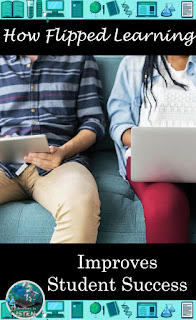I hate giving notes in class. I’ve never like it. It seemed that some students went really fast and then waited around or started distracting others around them because they were board. Other students took forever to write the notes because they either had a learning disability, they were a language learner, or they liked everything to be perfect and so they kept erasing and writing over again. It just didn’t seem like an efficient way to get the information to my students. By the time the notes were done we had little time to practice the information and had to finish for homework. This resulted in some of the students practicing it wrong or not doing it because they were still confused. I struggled to find time to get beyond the basics and into the higher level of thinking within our pacing guides. There had to be a better way.
This is where the flipped classroom model comes in. I
discovered this model a few years back. It was exactly what I was looking for. Students could watch a video on the topic at home and take notes at their own pace. Then we could discuss what they learned in class the next day and practice the information with the help and guidance of me, the teacher, and their peers. Using this model I was able to cover the basics faster and spend more time having my students engaged in higher level thinking about the topic. It took only a few lesson using this new model with my students for them to get used to it and they ended up preferring it over the traditional model in class. Here are some of their comments about the flipped lessons they left for me when I gave them an end of the year survey.
– G. Martinez writes: I enjoyed how you introduced us to flipped lessons, because this allowed us as students to learn at our own speeds and review the material if we needed it.
– N. Andrade writes: I enjoyed the flipped lessons because they helped me understand the topic due to the questions asked and notes.
– V. Reyna writes: I really like how the videos explain everything thoroughly and we get to answer questions throughout to see if we understand. Additionally, i can take my time.
– S. Camacho writes: I like flipped lessons because they can be done online, practically anywhere.
So what is flipped learning?
The flipped learning model rearranges where students take notes and practice their information. In a traditional classroom the notes are given by the teacher in class. The students then practice a couple of problems before doing most of the practicing at home on their own. The flipped classroom changes things. The students take notes at home and then spend in time in class practicing the information with the teacher. Reversing the location of these two decreases the level of frustration and misunderstanding in students. It also allows you to make corrections at the first sign of confusion before bad habits are made.
Why is flipped learning becoming more popular?
In the last few years we are seeing an increase of technology in the classroom and and increase in access to technology at home. With this access to technology teachers are looking for new ways to use it in their class. Teachers are finding many benefits of using the flipped model not only for their students but for them as well.
Benefits for students:
– Students are able to practice the information in class and get the help they need when they are stuck or loss from the teacher or other students.
– Students become less frustrated when they learn new material and they have less of a chance of practicing the information incorrectly.
– Students learn the skill of note taking and improve their ability to take notes on their own.
– When students are absent they can quickly get caught up.
– Students can watch the videos over and over again.
Benefits for teachers:
– Once the video is created it is there to use year after year.
– When students are going to be gone the teacher can just assign the video for them so that they don’t get too far behind.
– Teachers can choose how long they need to focus on each student and can better meet the needs of each one.
– It helps students understand the information quicker leaving more time for higher level projects and activities.
– If a teacher is going to be absent they can assign the video to be done in class with the substitute making sure that the lesson is taught the way they want it to be taught.
– Parents can watch the videos along with their students which helps them become more involved with their students learning.
In 2014, the Flipped Learning Network and Sophia.org conducted a study about the flipped classroom, surveying over 2,300 flipped educators about their experience. The following infographic shows what they discovered.

Find more education infographics on e-Learning Infographics
Are you ready to Learn the basic steps for flipping your class?
A flipped class has four main parts to it. I created the acronym FIRE to help explain these four parts. F: Format, I: Interact, R: Review, E: Expand.
The format identifies how you are going to give the information to your students.
Interact is about what students are going to do with the information.
Review goes over how the students will reflect on their understanding of the topic before coming into class.
Expand is what I feel is the most important part. Its about what the students will do in class the next day.
For more detailed information on how to do each part, check out my blog post about flipping your class in four easy steps by clicking HERE.
Get started with this FREE guide to flipped learning

Subscribe to get our latest content by email.
We won’t send you spam. Unsubscribe at any time. Powered by ConvertKit






